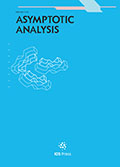Authors: Brada, A.
Article Type:
Research Article
Abstract:
Cet article a pour but l'étude du comportement asymptotique de la solution d'équations d'évolution du second ordre, de la forme: \begin{equation}\left\{\begin{array}{l@{\quad}l}\frac{\partial^{2}u}{\partial t^{2}}(t,x)+\Delta u(t,x)-\beta(u(t,x))=0&\mbox{ dans }\mathbf{R}^{+}\times\Omega,\\[4pt]u(0,x)=u_{0}(x)&\mbox{ dans }\Omega,\\\mbox{condition sur }\partial\Omega \mbox{ lorsque }\Omega \mbox{ est born\'{e}}&\\\mbox{ou condition de bornitude \`{a} l'infini},\end{array}\right.\end{equation} Ω étant, soit un ouvert borné de RN (partie I et II), soit RN (partie III), et β une fonction continue, monotone, sur R. De nombreux résultats ont été obtenus ces dernières années sur de tels sujets, notamment par H. Bérestycki et L. Nirenberg dans [4], puis par V.A. Kondratiev et O.A. Oleinik (voir
…[11] et [12]). Dans [4], H. Bérestycki et L. Niremberg étudient, entre autres, des équations du type \begin{equation}\Delta u-\beta(y)\frac{\partial u}{\partial x_{1}}+g(y,u)=0\quad \mbox{ dans }\mathrm{S}\end{equation} où S={x=(x1 ,x2 ,…,xn ); y=(x2 ,…,xn )∈Ω}, Ω étant un domaine borné de Rn−1 . Dénotant par \[a(y)=-\frac{\partial g}{\partial u}(y,0)\] (avec g(y,0)=0), et désignant par λ1 la première valeur propre de l'opérateur (−Δ+a(y)) dans Ω, avec condition de Dirichlet sur ∂Ω, ces auteurs montrent que pour β=0, et sous l'hypothèse λ1 >0 (et fonction propre correspondante ϕ>0), il existe une constante positive α telle que la solution u de (2) avec condition de Dirichlet u=0 sur ∂S, vérifie: \[u(x_{1},y)=\alpha \mathrm{e}^{-\sqrt{\lambda_{1}}x_{1}}\phi(y)+\mathrm{o}(\mathrm{e}^{-\sqrt{\lambda_{1}}x_{1}})\] lorsque x1 →+∞. Des résultats analogues sont aussi prouvés lorsque des conditions de Riemann sont imposées sur ∂S. Les résultats que nous proposons ici sont, pour certains, antérieurs aux travaux cités ci-dessus (voir [5]): ils font suite à ceux obtenus par L. Véron et P. Baras dans [2], et L. Véron et A. Gmira dans [9] et [10], pour l'équation parabolique: \begin{equation}\left\{\begin{array}{l@{\quad}l}\frac{\partial u}{\partial t}(t,x)-\Delta u(t,x)+u(t,x)|u(t,x)|^{p-1}=0&\mbox{dans }\mathbf{R}^{+}\times \Omega\ (p>1),\\[4pt]u(0,x)=u_{0}(x)&\mbox{dans }\Omega,\\\mbox{condition au bord si }\Omega \mbox{ est born\'{e}}\\\mbox{ou condition \`{a} l'infini si }\Omega =\mathbf{R}^{N}.\end{array}\right.\end{equation} Ce travail comporte trois parties: 1. Comportement asymptotique de la solution u de (1) dans un ouvert borné avec condition de Neumann au bord. Plus particulièrement, pour $\beta{:}\ r\mapsto r|r|^{p-1},p>1$ , et u0 ∈L1 (Ω), on obtient: \[\lim_{t\to +\infty}t^{\frac{2}{p-1}}u(t,x)=l\in\left\{\pm\biggl[\frac{2(p+1)}{(p-1)^{2}}\biggr]^{\frac{1}{p-1}},0\right\}\] uniformément sur $\overline{\Omega}$ . On peut, en outre, préciser ce qui se passe si l=0: il existe un entier k>0 telle que $\mathrm{e}^{\sqrt{\lambda_{k}}t}u(t,\cdot)$ converge, pour t→+∞, vers un élément non nul ψk (·)∈ker(Δ+λk id) (λk étant une valeur propre de −Δ dans Ω). 2. Comportement pour des conditions de Dirichlet au bord. Pour u0 ∈L2 (Ω), et en désignant par λ1 la première valeur propre de −Δ dans Ω, on montre que \[\lim_{t\to+\infty}\mathrm{e}^{\sqrt{\lambda_{1}}t}u(t,\cdot)\in \mathrm{ker}(\Delta +\lambda_{1}\ \mathrm{id}).\] Cette limite est donc de la forme αh0 , h0 étant un générateur du sous-espace propre: on étudiera alors quelques propriétés de l'application $u_{0}\mapsto \alpha$ . En particulier, pour β(r)=r|r|p−1 et α=0, il existe une valeur propre λk de −Δ dans Ω, telle que \[\lim_{t\to+\infty}\mathrm{e}^{\sqrt{\lambda_{k}}t}u(t,\cdot)\in \mathrm{ker}(\Delta +\lambda_{k}\ \mathrm{id}).\] 3. Comportement asymptotique dans RN . Ici aussi, il dépend essentiellement du signe de p−(N+2)/N et de la décroissance de u0 . On aura: \[\lim_{t\to+\infty}t^{\frac{2}{p-1}}u(t,x)=\biggl[\frac{2(p+1)}{(p-1)^{2}}\biggr]^{\frac{1}{p-1}}\] pour u0 ≥0 et \[\lim_{|x|\to+\infty}\mathrm{ess}|x|^{\frac{2}{p-1}}u_{0}=+\infty.\] Pour u0 ∈L1 (RN ) et p≥(N+2)/N, on obtient: \[\lim_{t\to+\infty}\left[t^{N}u(t,x)-C\frac{t^{N+1}}{(t^{2}+|x|^{2})^{\frac{N+1}{2}}}\right]=0\] uniformément sur les ensembles de la forme {x∈RN : |x|≤ct}. En outre, si p=(N+2)/N, C=0.
Show more
DOI: 10.3233/ASY-1995-10402
Citation: Asymptotic Analysis,
vol. 10, no. 4, pp. 335-366, 1995
Price: EUR 27.50





